The 1978 NCAA men’s championship marks an important point in the history of college golf. The change to a scoring format known as “daily” or “day-by-day” scoring - where the team’s best [4] scores are officially counted on a daily basis rather than waiting for the end of the tournament - was said to provide flexibility along with an emphasis on the team over the individual. Today we look at the history behind the change and dive into the past results to see just how much the record books might have been altered by that decision.
*NOTE: underlined text provides a link to references or sites with more information
AGGREGATE SCORING HISTORY
Going back to college golf’s return from a World War (the First one) the team title has been determined by the best four scores from as many as six players. In 1960 this was reduced to 5 players for the NCAA champion and most other tournaments. Although anywhere from 36 to 72 holes of stroke play were used to determine the team championship between 1920s to 1970s, the common format was that the team’s best four “aggregate” scores at the end of those holes would determine the team total. That changed in the late 1970s with the adoption of the “daily” format now used exclusively for all tournaments including the NCAA championship.
WAKE FOREST DOMINATES IN 1975
Although there doesn’t seem to be a source that can definitively indicate the reason for the change from aggregate to daily scoring, several credible sources over the years points back to the Wake Forest domination in the 1975 championship as the likely impetus. Their 33-stroke win remains the largest team margin of victory as of 2024. Second largest margin is held jointly by Stanford in 1941 and Ohio State in 1945 (5 total teams) who won by 19 strokes each in just 36 holes. Of the 72 hole finishes, the previous largest margin was Texas’s 1972 victory by 13 strokes which was bested by the 1989 Oklahoma Sooners and their 19-stroke win.
The 1974-75 Wake Forest team - boasting sophomore (and reigning NCAA champion) Curtis Strange and junior Jay Haas - ran through the regular season in such a dominant fashion that a Golf World article written by Ryan Herrington in 2001 would dub them the best college golf team ever. Leading up to the 1975 championship, the defending NCAA champs accumulated 7 tournament titles including their 9th straight ACC championship - which they won by 36 shots - and Strange defending his ACC individual title. This same article suggests rather unambiguously that this championship slaughter caused the NCAA golf committee to examine ways to prevent it from happening in the future.
SWITCH TO DAILY SCORING
Two more seasons would pass before the NCAA committee, chaired by legendary Duke head coach Rod Myers, officially voted to implement the change to daily scoring. This wasn’t a completely novel concept as other team golf such as the NAIA had used it before (since at least 1972) and so had DII the previous year, but it was a major shift for D1 golf. The ultimate goal was to put an emphasis on the team play and provide flexibility so that a player that shot an outrageous score in an early round, had to withdraw, or was even disqualified could still contribute to the team score in other rounds.
1978 Championship
In some ways the 1978 championship was a false-start on the validity of the new scoring format and indeed might not have stuck around if it hadn’t been for a family emergency. Duke Coach Rod Myers was the chairman of the NCAA golf committee 1977-81 and helped usher in one of the most lasting and impactful changes in college golf since moving to 5count4 in 1960. Looking to emphasize the team aspect, Myers and the NCAA committee voted to make two big changes: moving to 5count4 “daily” scoring and stopping the individual title race after 54 holes to make the final 18 holes count only towards the team title.
The 54+18 team-only format was universally disliked - with one player describing it as “surreal” playing those last 18 holes - and was abandoned after that year. The 5count4 daily scoring was retained, likely due in part to its unfortunate application when one of Georgia’s top players, Gus Holbrook, had to leave suddenly after two rounds after being informed his father had a serious complication following heart surgery. Holbrook was a counting score in the first round but was understandably unsteady in the second round. In the end, the four strokes Georgia saved under the new format from Holbrook counting in the first round would not have made a difference to their overall runner-up finish had they still been using the aggregate system, however people saw just how flexible this new system was even if they still didn’t like it. Probably also didn’t hurt that Oklahoma State - one of the top favorites and led by one of the most vocal coaches in the sport - ended up taking home the team title.

**Some added irony about the above quote: Coach Knight’s team did end up making use of the system when freshman John Fields had his 2nd round scorecard thrown out after signing for an incorrect score. UNM would have missed the cut either way, but that probably didn’t give much solace to the first year head coach or his players.
1979 Championship
Coaches were still not fully convinced going into the 1979 championship, hosted by Wake Forest. The below column in the local newspaper, the Sentinel, makes for some interesting reading. In the end, Ohio State was the one to hoist the team trophy over Oklahoma State. Although there are no newspaper or other sources to quote Coach Holder’s reaction, it seems pretty obvious that he probably did some math to see that had they still been using the previous aggregate system, the Cowboys would have repeated as champions. Despite any personal disagreement(s), the coaches seemed to be on board with the committee changes, and we haven’t yet found any public disagreements after the 1979 championship.
ANALYZING THE DATA
So it begs the question: what if the NCAA D1 men’s championship hadn’t made the switch to daily scoring?
Note that this is broken down into three sections with an emphasis on the tournaments prior to the implementation of team match play in 2009. The match play era (2009-present) has been covered fairly extensively in a previous post which is linked below.
1975 - 1977 [5count4 Daily]
First, just for fun, let’s see what might have happened if they had used the new 5count4 “daily” format for that infamous 1975 championship as well as the next two years before it was officially implemented.
1975
Using the 5count4 daily scoring would have saved Wake Forest four strokes, but it would have saved 2nd place Oklahoma State 10 strokes. Instead of a 33 stroke victory, Wake would have “only” won by 27 strokes, still a record. The biggest changes would have been for Houston and Texas who would have swapped places to finish in 10th and 7th respectively.
1976
Both 1st place Oklahoma State and runner-up BYU would have saved 10+ strokes each under the new format, however Ok St would have still taken the title by six strokes.
1977
Houston ran away with the team title by eight strokes, but would have extended that to a 13-stroke victory over Oklahoma State. Instead of finishing T3 with Arizona State, Georgia would have finished T2 by gaining eight strokes under the new format.
1978 - 2008 [5count4 Aggregate]
So far we haven’t seen any dramatic changes going from the aggregate to the daily format for the last three years, however things get pretty interesting if we looked at the finishes from 1978-2008 using the older aggregate format. In those 30 years (31 championships) there are actually 12 championships (38%!) in which the winning team is affected in some way. Here are the changes:
1979 => the Ohio State team, led by All-Americans Joey Sindelar and John Cook, earned a two-stroke victory over reigning champs Oklahoma State using the still new daily format. Had they been under the old aggregate scoring system, Ohio State would have lost 14 strokes to OSU’s 7, flipping the finish of the two teams and giving Coach Mike Holder a five-stroke win and his third title just four years into his young career!
1980 => things would have gotten interesting for Coach Holder’s OSU team the following year as they chased the three-peat. Instead of finishing clear of BYU by four strokes, the Cowboys would have been tied with the Cougars and Oral Roberts after 72 holes. This would have been an epic matchup for the first-ever NCAA playoff had it occurred, instead that wouldn’t come until 1995 (but also involved OSU).
1981 => for the third year in a row, and just four years into this new format, the top finishing team under the daily format would have been affected had they still been using the aggregate. Oral Roberts, under Coach Bill Brogden, would have seen a two-stroke loss turn into a one-stroke victory over BYU.
1984 => legendary Houston Coach Dave Williams famously picked up team titles #15 and #16 in back-to-back years at the tail end of his coaching career. Had they been under the old format, the first of those two titles would have been a fierce playoff against rival (and reigning champ) Oklahoma State as Houston would have lost its one-stroke advantage. Now this would have been a guaranteed instant classic, pitting Houston’s Steve Elkington/John Slaughter/Billy Ray Brown/Tray Tyner/Steve Russell against Ok St’s Tommy Moore/Andy Dillard/Jeff Maggert/Scott Verplank/Kevin Whipple!
1985 => the second of those two title would have been lost outright to Oklahoma State as Houston would lose a whopping 11 strokes under the old format, turning a three-stroke win into a seven-stroke loss. Using the old format, Houston Coach Dave Williams might have only had 14 championships instead of 16, and OSU Coach Mike Holder could have had as many as three extra trophies (with the potential to have lost his 1980 title due to playoff).
1990 => Arizona State accomplished something incredible when the program won both the men’s and women’s team championships in 1990. The Sun Devil two-stroke victory would have turned into a three-way tie between ASU, Arizona, and Florida using the aggregate format. Sun Devil sophomore - and already a two-time individual champion - Phil Mickelson would have had to do battle against the likes of Dudley Hart/Chris DiMarco of Florida and Manny Zerman/Jim Furyk of Arizona in the third team playoff in the last 10 years after not having one since the NCAA took over in 1939!
1993 => the 92-93 Georgia Tech team which included David Duval, Stewart Cink, Carlos Beautell, Mikko Rantanen, and Tommy Johnston came achingly close to the program’s first program championship when they fell a single stroke short of Florida (their third). Using aggregate scoring they would have won by seven strokes.
1994 => with everyone knowing that superstar freshman Tiger Woods would be joining the team the following season, Stanford was a surprise winner in 1994. Using the aggregate total, Stanford would have lost 10 strokes, turning a 4-stroke victory into a 2-stroke runner-up finish to Texas (their first since 1972, but instead they would have to wait until 2012 to get their next!)
1995 => this one is a little different since the only thing that changed would be Oklahoma State winning outright instead of winning a playoff over Stanford, however we would have been robbed of one of the great moments in college golf history, not to mention a pretty good book!
1996 => The Sun Devil men won their second team title of the 1990s the year after the women three-peated. Under the old scoring format, head coach Dwaine Knight and assistant coach JT Higgins bring UNLV its first team title by a single stroke.
2000 => the 2000 championship held at Auburn’s Grand National was a wild one which saw record scoring from legendary Oklahoma State senior Charles Howell III. Despite strong play by his teammates, the final 72-hole result left the Cowboys tied with a Georgia Tech team that included Matt Weibring, Bryce Molder, Carlton Forrester, Matt Kuchar, and Troy Matteson (2002 individual champ). Once again the Cowboys prevailed in a sudden-death playoff. With aggregate scoring, neither of these teams would have held the title as instead Arizona, led by Ricky Barnes - would have prevailed by one stroke over OSU and two over Georgia Tech. This would have been the second title for Coach Rick LaRose (1992).
2003 => the 2003 championship at Karsten Creek is infamous for the difficult conditions and resulting high scores. Coach Larry Penley finally got the team title his teams had been so close to capturing for many years when they outpaced the home OSU team by two strokes. Under aggregate scoring, UCLA - led by new head coach OD Vincent - would have maintained their same score and risen from third up to first in a six stroke victory.
2009 - Present
Since 2009, the men’s D1 team championship has been determined by placing the top 8 teams after 54 (2009-14) or 72 holes (2015-present) of stroke play into a match play bracket. The following graphics gives an idea of how the championships might have gone if you look at just the stroke play results, **understanding that teams likely play much differently in (at least) the final round if their goal is to finish on top rather than only needing to make the top 8. The results are pretty interesting when you compare who did win - shown in the left-most column - compared to who would have won with either the aggregate or daily scoring over 54 or 72 holes.
If you want to explore this topic more, check out our post from 2023. We intend to do another What-If post on the 1978-2008 timeframe looking at what the match play brackets might have looked like. Should be fun!
Thanks for reading!






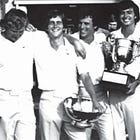
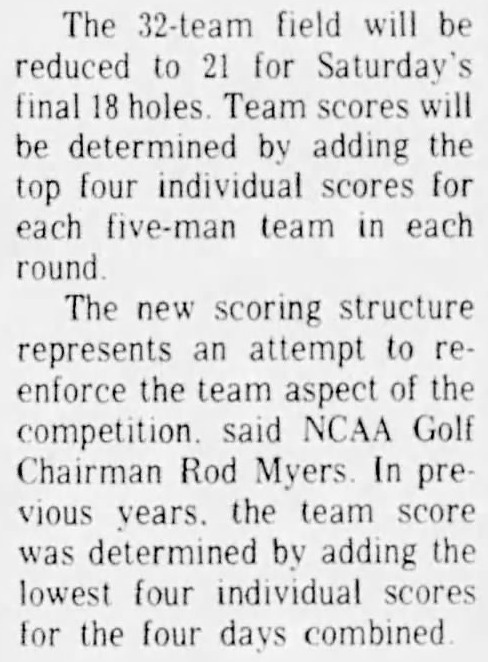

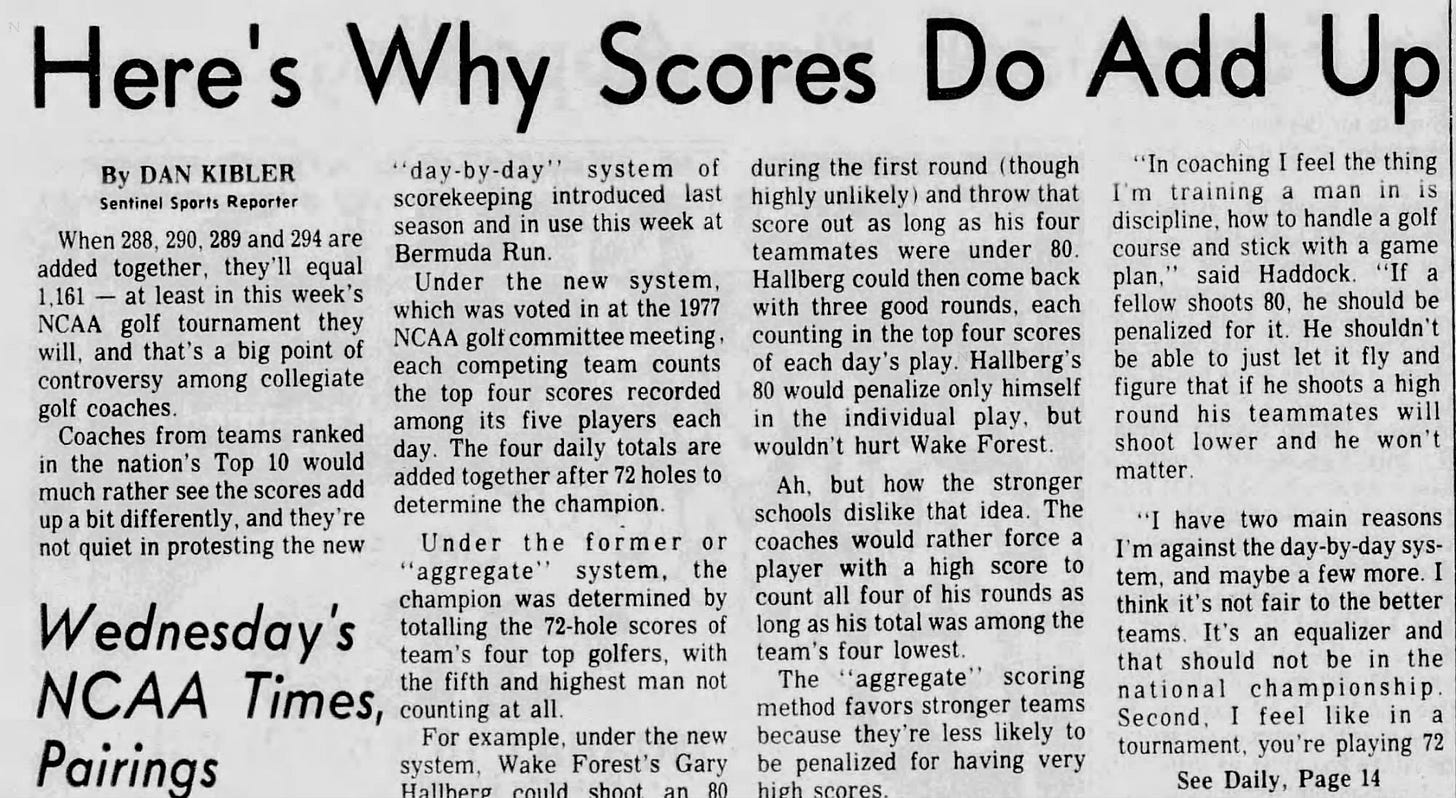
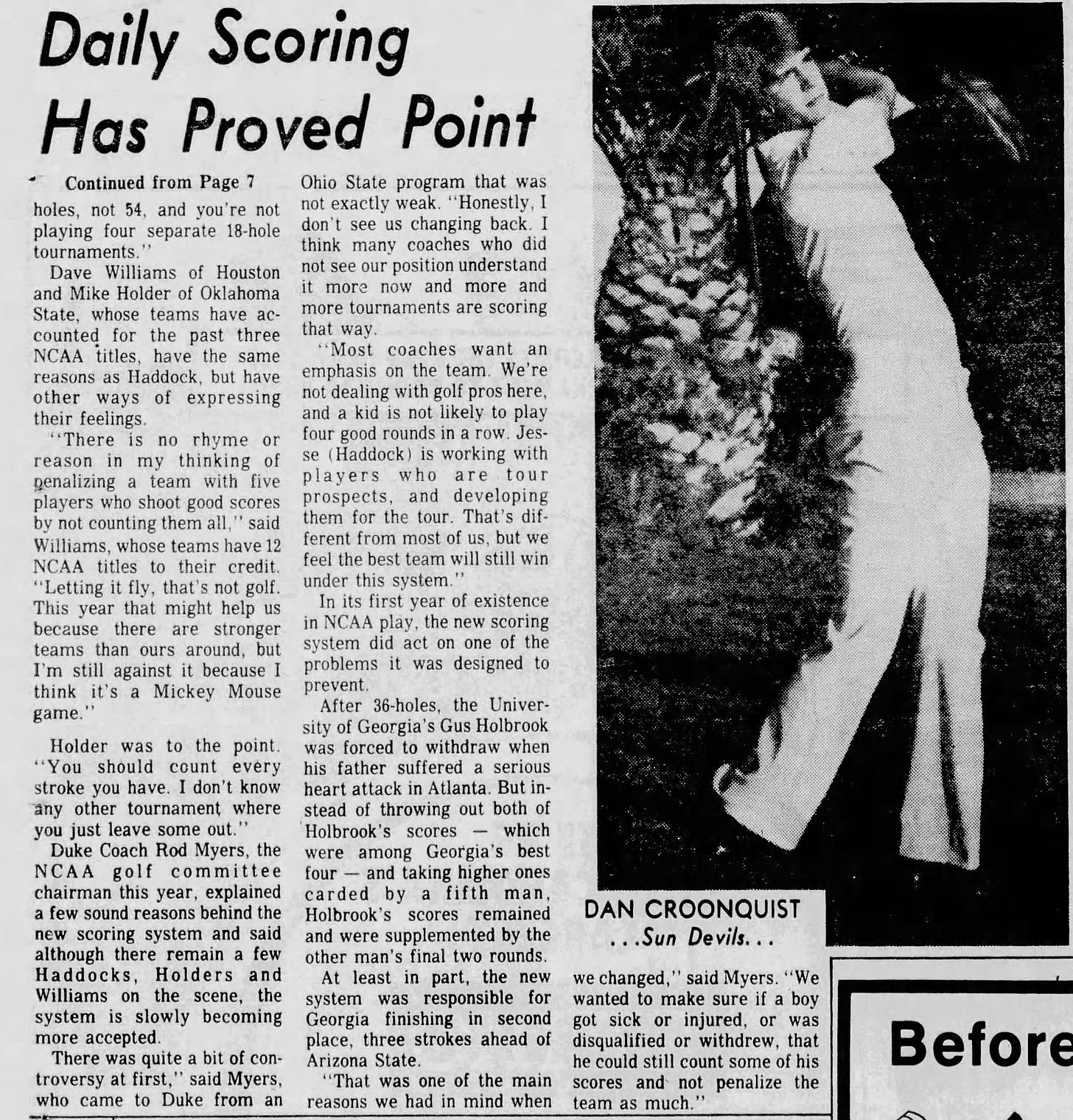


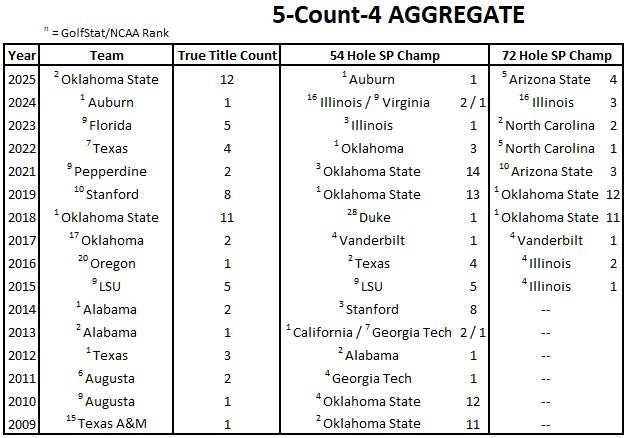
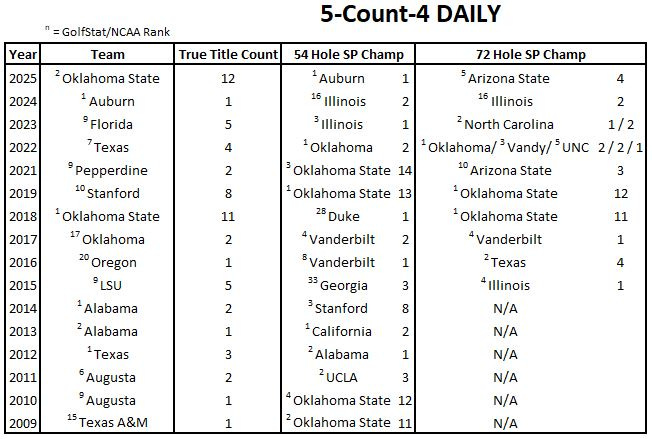

It’s really neat to hear the back story on how this rule came into play.